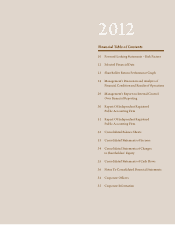Cracker Barrel 2012 Annual Report Download - page 20
Download and view the complete annual report
Please find page 20 of the 2012 Cracker Barrel annual report below. You can navigate through the pages in the report by either clicking on the pages listed below, or by using the keyword search tool below to find specific information within the annual report.
Labor and Related Expenses
Labor and other related expenses include all direct and
indirect labor and related costs incurred in store operations.
Labor and other related expenses as a percentage of total
revenue were 36.8%, 37.1% and 37.8% in 2012, 2011 and
2010, respectively. e year-to-year percentage change from
2011 to 2012 resulted from the following:
2011 to 2012
(Decrease) Increase as a
Percentage of Total Revenue
Store hourly labor (0.3%)
Health care costs (0.2%)
Store bonus expense 0.2%
e decrease in store hourly labor costs as a percentage of
total revenue resulted from improved productivity due to our
enhanced labor management system and menu price increases
being higher than wage ination.
e decrease in our health care costs from 2011 to 2012
resulted from a change in our group policy. Employee health
care expenses in the calendar 2011 plan year were lower due
to improvements in claims experience. As a result of these
improvements, we negotiated a retrospectively rated group
policy during the rst quarter of 2012. is policy is retroac-
tive to January 1, 2011 and provides for a reimbursement of
health insurance premiums based on actual claims experience
through the end of calendar year. e terms of this policy
resulted in us receiving approximately $5,200 in net reim-
bursement for these health insurance premiums during 2012,
which reduced our health care costs. is reduction was
partially oset by higher claims experience in 2012. Addition-
ally, we do not expect to receive a reimbursement for health
insurance premiums in 2013 and have included a provision
for a retroactive increase during the second half of 2012.
Higher store bonus expense in 2012 as compared to 2011
reected beer performance against nancial objectives in
2012 as compared to the prior year.
e year-to-year percentage change from 2010 to 2011
resulted from the following:
2010 to 2011
Decrease as a Percentage
of Total Revenue
Store management compensation (0.3%)
Health care costs (0.2%)
Store hourly labor (0.2%)
e decrease in store management compensation resulted
primarily from lower store bonus expense, which reected
lower performance against nancial objectives as compared to
the prior year. e decrease in health care costs resulted from
lower medical claims. e decrease in store hourly labor costs
as a percentage of total revenue resulted from menu price
increases being higher than wage ination.
Other Store Operating Expenses
Other store operating expenses include all store-level operating
costs, the major components of which are utilities, operating
supplies, repairs and maintenance, depreciation and amortiza-
tion, advertising, rent, credit card fees, real and personal
property taxes and general insurance. Other store operating
expenses as a percentage of total revenue were 18.0%, 18.6%
and 18.2% in 2012, 2011 and 2010, respectively.
e year-to-year percentage change from 2011 to 2012
resulted primarily from the following:
2011 to 2012
(Decrease) Increase as a
Percentage of Total Revenue
Utilities (0.2%)
Litigation selement (0.1%)
Credit card fees (0.1%)
Supplies (0.1%)
Advertising 0.2%
e decrease in utilities expense from 2011 to 2012 resulted
primarily from lower natural gas costs.
In the rst quarter of 2012, we received proceeds from a
litigation selement and recorded the proceeds as a gain in
other store operating expenses since the selement related to
a maer previously recorded in other store operating
expenses. Because we believed this selement represented a
gain contingency, we did not record the gain until the
selement amount and timing were assured.
e decrease in credit card fees from 2011 to 2012 resulted
from a reduction in debit card fee rates due to a change in
Federal law governing such fees. We believe that the decrease
in supplies expense as a percentage of total revenue from
2011 to 2012 resulted primarily from our eorts to control
this expense.
e increase in advertising expense from 2011 to 2012
resulted from our change in advertising strategy during 2012
in which we spent more on television advertising than in
18
























